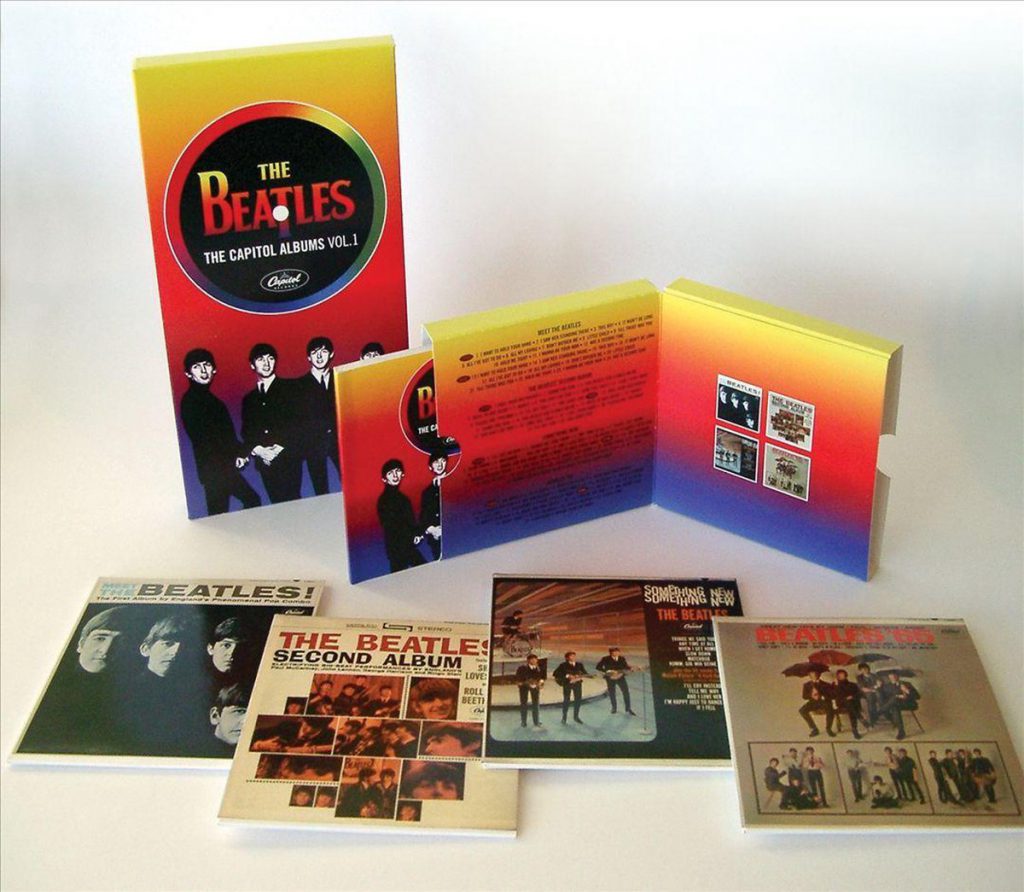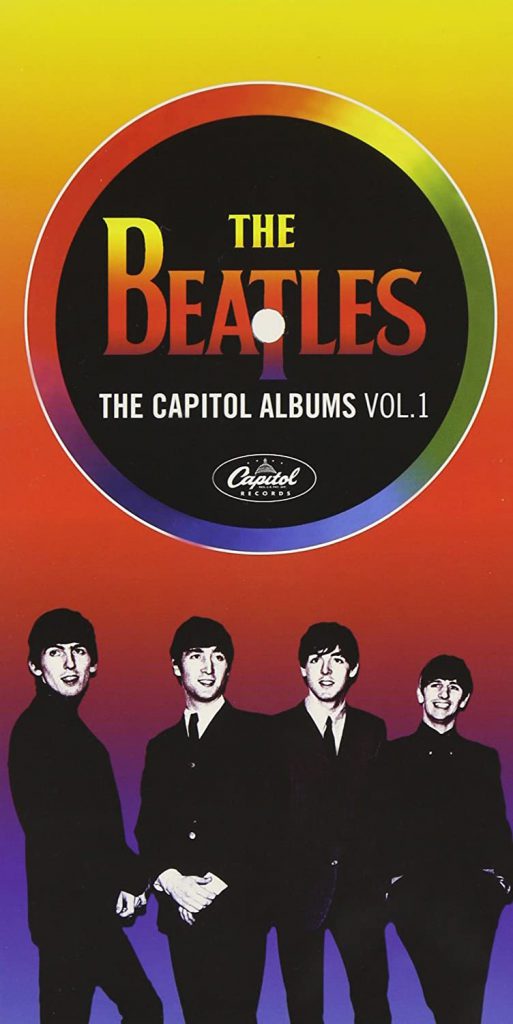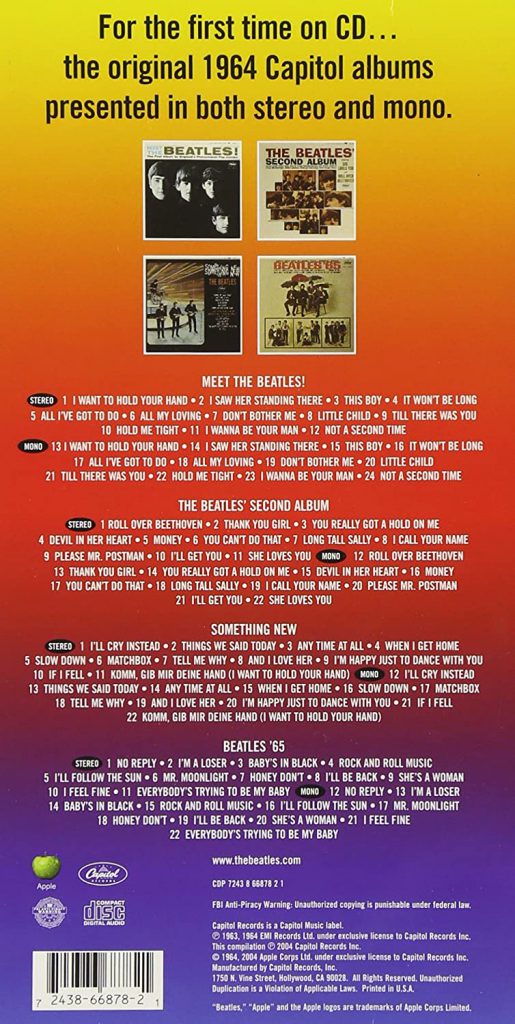The four albums in this box were first issued by Capitol during 1964, a sensational year, in circumstances that had never been experienced and have not been repeated. They sold in millions, they re-energized a troubled U.S. music business, and they helped fashion contemporary and future generations. And yet these albums have not been issued on CD before now.
The Beatles’ 1962 contract with EMI gave the British record company world rights. EMI marketed the Beatles around the globe through an intricate network of licensees and sub-licensees. During the course of the 1960s, the Beatles’ work as they intended it – singles and albums, each creatively distinct from their predecessors – changed in structure, configuration, appearance and sometimes title from country to country. No global economy existed, nor the measure of artistic control common today.
Capitol, owned by EMI, several times spurned the chance to release the Beatles’ early singles in America. This was a straightforward business decision based on a fact repeatedly proven – before the Beatles, the U.S. market for British music was close to non-existent. No American company issued their debut single Love Me Do. Succeeding singles Please Please Me and From Me To You were put out by Vee-Jay, a Chicago independent, and She Loves You by a Philadelphia label, Swan.
It was only in November 1963, when news of the Beatles’ extraordinary impact in Britain was spreading internationally, that Capitol struck an agreement with EMI to issue the Beatles in America. The company scheduled the single I Want To Hold Your Hand and an album, Meet The Beatles!, for January 1964 and pledged an extensive promotional campaign initiated by Beatles manager Brian Epstein. Capitol’s intention was to make 1964 ‘The Year of the Beatles”. It’s less likely that anyone believed it possible.
Earthquakes occur with devastating speed. Brought forward to the last days of December 1963, I Want To Hold Your Hand came out, reached its audience through heavy radio play, was bought by hundreds of thousands, and shot to number one by mid-January. The speed left music industry observers astounded. Meet The Beatles!, then raced to the top of the album charts with the same rapidity. This was already history in the making … and the story had scarcely started.
The Beatles had been sold to the American pop public – almost entirely teenagers – on a sound. Television had scarcely touched them, teen shows not at all. Most fans had their first sighting of the Beatles with their purchase of I Want To Hold Your Hand. The sleeve was a stock publicity shot which Capitol happened to have on file. It showed Paul, Ringo, George and John, six months earlier. Already moving fast, they had since ditched the collarless outfits.
The photo on Meet The Beatles! – Robert Freeman’s artfully half-shadow shot – was only a little more recent, but still reflective of the Beatles’ creative intent. Here, though, Capitol’s liner-note writer had a hilarious handle on the way (he thought) the British spoke. ‘A year ago the Beatles were known only to patrons of Liverpool pubs,’ he began. ‘Today there isn’t a Britisher who doesn’t know their names.’ A pen-portrait section added, ‘They wear ‘pudding basin’ haircuts that date back to ancient England.’ The words were absorbed by fans eager for any scrap of information.
Before the Beatles touched down in America on 7 February 1964 – they happened to be booked on The Ed Sullivan Show – it as widely felt that the TV appearance could mark the end of the phenomenon. But when a record-breaking 73 million tuned in and saw the Beatles, the takeover became absolute. In a historic moment never likely to be equaled, the Billboard chart of 4 April 1964 had the Beatles in all top five places.
The four discs in this set were issued by Capitol in January, April, July and December 1964. Key Beatlemania albums, they held the Billboard number one spot for 25 weeks.
Buyers did not know (or necessarily care) that these were Capitol’s compilations, bearing scant resemblance to the recording pattern the Beatles led in their home country. The Beatles were not consulted over the song selections or the album titles, which were often chosen by Capitol conscious of commercial battles with Beatles recordings on other labels. (The Beatles’ Second Album was the second Capitol albums but the Beatles’ third in the U.S. Vee-Jay also had one.) On stage in the three years they toured the States, 1964 to 1966, the Beatles would introduce songs along of the lines of ‘…er, I think this one’s on Something New.’
It was only in 1987, when their albums were released on CD for the first time, that the Beatles were able to control their product universally. Naturally, they issued everything everywhere the way they had always wanted it. Inevitably, millions around the world had to adapt to titles, artwork and track listings alien to the albums they knew and loved.
This box helps complete the story, for irrespective of the how-and-why of their release, the Capitol albums remain absolutely emblematic of 1964, and are packed with the music that, for many, will evoke still the adrenaline-rush of Beatlemania.
This is the soundtrack of that authentic – and inspirational – revolution.
Mark Lewisohn


